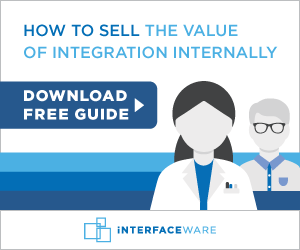For a patient, nothing is quite as frustrating as navigating the healthcare system and being required to bring your documentation to every department. Likewise, when a simple phone call to inquire about billing or appointments turns into an hour-long adventure of being transferred from department to department and explaining a situation repeatedly, a patient can become frustrated and disenchanted with the entire healthcare process. Customer service and continuity of care is the most important reason to integrate systems and share information between departments. However, integration also serves a purpose for those within the organization, including a reduction in manpower and reduced frustrations when providing patient care. By reducing stress and frustration for healthcare providers and staff, the benefit to the patient is automatic.
 If your organization is in the midst of integrating systems or your executive management team is just now discussing the process, you may not be convinced that integration is the way to go. The task can seem daunting at the outset, and the cost to integrate may seem out-of-reach. However, the reasons for integration far outweigh the arguments to delay or avoid the process entirely.
If your organization is in the midst of integrating systems or your executive management team is just now discussing the process, you may not be convinced that integration is the way to go. The task can seem daunting at the outset, and the cost to integrate may seem out-of-reach. However, the reasons for integration far outweigh the arguments to delay or avoid the process entirely.
Executive Management Team
The Roman playwright Plautus is credited with the adage “You must spend money to make money.” This quote still holds true today. When you invest money into your organization, especially in the Information Technology sector, you will see a huge return on your investment. Streamlining technology and information sharing processes will allow your organization to service patients in a more effective and efficient manner. These efficiencies help cut down on manpower and increases the number of patients you can serve in your community. Since more patients mean more inflow of cash, this increases your bottom line, makes you look better to shareholders and others with an interest in your organization. A well-integrated environment makes your organization more able to withstand the effects of a recession.
Finance and Business Departments
Those in the Finance and Business offices deal with paying the bills to keep the organization running. These offices also deal with patient billing and accounting for incoming funds as well as outgoing funds that keep the bills paid. With patient billing, however, comes billing issues. It can be difficult to deal with patient frustrations over billing issues and account problems. To help manage these challenges and maintain financial stability, consider exploring strategies for business insolvency. Develop Your Action Plan Today to ensure a proactive approach to any potential financial difficulties.
When systems are not integrated, this frustration is compounded.
When systems are integrated, however, one user can pull information from several places to get a full picture of the patient’s account. With a streamlined billing process, fewer patient’s accounts will become overdue. These improvements culminate in better service to the patient and less stress and headache for staff members. It also decreases administrative costs, including costs associated with chasing down past-due payments and referring accounts to outside collections agencies. A Health Affairs study shows that approximately 12% of patient revenue is spent on administrative costs; 74% of this number is wasted on billing inefficiencies. When the billing process is streamlined by integrating systems, these expenses can be drastically reduced. And if you had to take out loans to start your healthcare business, you may want to seek an Expert Company Debt Advice UK to make it easier for you to manage your financial liabilities.
Clinical, Administrative and Operational Departments
Perhaps the areas most impacted by the integration of systems are the clinical, administrative and operational departments. Let’s start with the clinical area – physicians, nursing staff and other practitioners. The average provider spends nearly 17% of their time on administrative chores, to include paperwork and add computer entries. These tasks increase frustration for the practitioner and decrease the amount of time they have to interact with patients and staff. It also decreases the amount of patients that can be served by one provider and in turn decreases the efficiency and profitability of the organization.
Another huge impact of systems integration involves coding and coding errors. With the recent release of ICD-10, there have been some glitches that have resulted in errors in patient records and billing issues. When systems don’t see each other or communicate, these problems are compounded. When the effort is taken to integrate all systems, these errors are reduced, and patients receive better care.
Another issue in this area is employee satisfaction and turnover. Employees who have to chase down information from other departments are going to be frustrated and disillusioned. Hunting down information takes time away from job performance and training opportunities. According to the American Management Association, many employees cite a lack of manpower as one of the primary reasons they are unable to receive the training they need to perform their jobs. If there is no one available to cover for them and pick up the slack while they are away from their desk, there is no way they can attend training sessions. Lack of training negatively affects the employee’s ability to perform their assigned tasks. This impacts the organization as a whole, degrades employee and organizational performance, and contributes to employee turnover. A 2011 article from SmartPros states that approximately 20% of employee turnover is caused by frustration in the workplace. A study by the Center for American Progress estimates that the cost of employee turnover is around 21% of each employee’s annual salary. If your organization is losing employees due to frustration over information systems, the cost of delaying integration can be astronomical from an HR standpoint.
Information Technology Department
The IT Department is the core of the organization as far as information sharing and systems integration. This department is where everything happens. During the process of systems integration, the toll on the IT Department is high. However, once integration is complete, the benefit to this department is well worth the investment to integrate. Users within the organization will need less assistance from IT, and calls to the Help Desk will be drastically reduced. Software issues will be reduced, as will the time required to repair software programs and grant users access to systems they do not have privileges in. These changes allow IT personnel to focus on upkeep and maintenance of critical systems.
During the process of integration, it is important for management personnel to ensure that IT professionals are on staff that understand the process of integration and have knowledge and experience in this area. It is also important that IT department managers are well-versed in the types of integration engines that are available so they can make recommendations to executives on which program is best to meet the organization’s needs. Whichever integration engine is chosen, it is important to select one that is customizable, easy-to-use and can support every system within the organization. A modern integration engine will cut down on the investment of time and funds required for the integration process.
Conclusion
The arguments in favor of systems integration far outweigh the concerns that cause decision-makers to delay the process. While integration may seem like a hassle at the beginning, those organizations that have been through the process and come out on the other side will be the first to admit that the process is worth it. The ROI is astronomical in terms of employee satisfaction and organizational profit. If your organization is looking to integrate information systems to streamline care, the time to get started is now.

